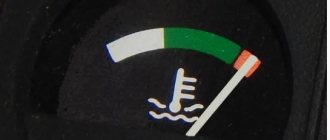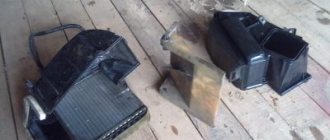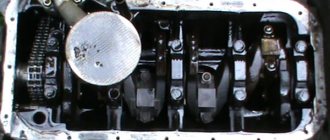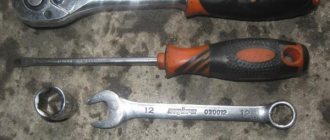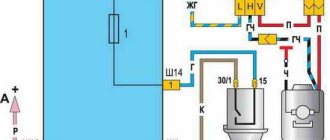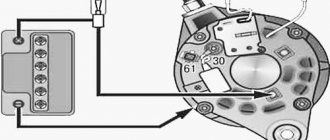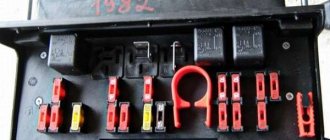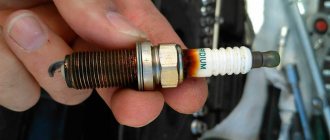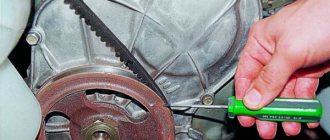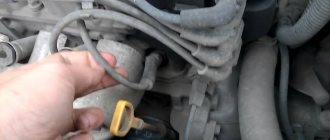Possible reasons why an injection engine does not start
Fuel system
It is necessary to diagnose the fuel supply system.
In domestic fuel-injected cars, when the engine starts, you can hear a specific buzzing sound from the rear of the car. This sound indicates that the fuel pump is operating. Accordingly, if such a buzzing noise is not observed, most likely the problem lies in the pump. You need to check the fuses that control the fuel pump, the main engine control relay and the fuel pump relay. In some cars of the VAZ family, fuses are hidden under the glove compartment, in others behind the heating panel cover on the passenger side. If the fuses are ok, check the relay.
You can touch it, and a specific click should sound. If the relay is also working properly, you need to check the pressure in the fuel system. The best way to do this is with a pressure gauge. If this is not possible, you will have to find a spool, which should be under a protective cap.
When you press it, you should feel pressure. Some models do not have a spool. Then you need to disconnect the fuel supply pipe. If the pump is working, then pressure should also be felt under your finger.
If it turns out that all elements of the fuel system are in order, then the next thing you should pay attention to is the ignition system
Ignition system
The main thing you need to be sure of is the presence of a good spark, that is, a discharge between the two contacts of the spark plug. If the starter turns, but the engine does not start, then there is a high probability of a malfunction in the ignition system. This is where we need our spark gap. If you check the spark plug without it, for example, by attaching it to the engine, then the resistance will be too high.
Therefore, we will not be able to accurately check our spark plugs and, in addition, the controller may be damaged. After checking the fuel system and ignition system and not finding the cause of the malfunction, you will need to check the engine. Most likely, this is the reason.
Starter malfunction
This can be a very common reason why the car engine does not start. In order to establish the possible cause of a starter failure, it is very good if the car enthusiast has at least an approximate understanding of the structure of this mechanism and how to check whether it is working.
It is important for owners of foreign cars to know that imported starters can stop turning even due to lack of lubrication or when dirty. In this case, the solution is very simple: remove the starter from the engine, thoroughly clean it from dirt and thoroughly lubricate the necessary mechanical components
Moreover, the used lubricant must be removed. In principle, this is not difficult, but if it doesn’t work out, then it’s better to contact a specialist.
Why is there no spark on a VAZ injection engine?
Some starter malfunctions can be determined by ear. If you turn the key in the ignition switch, the starter makes a click, but it does not start, then most likely the relay is faulty. If possible, then you need to repair it. If the relay cannot be repaired, then it is worth replacing it. Only dismountable types of relays can be repaired.
Accumulator battery
The battery must be undamaged and the terminals clean and free of oxide, otherwise there will be no good contact between the battery and the vehicle's electrical wiring. The battery must have sufficient charge and “hold” it.
If the battery has been used for some time in undercharge mode, then there is a very high probability of deep discharge, in which it will no longer be able to recover.
Wiring
Corrosion may form on wiring elements or at connection points, which prevents the normal flow of current. All contact pairs must be clean and the connections insulated.
Injectors
Injectors in a car rarely fail all together and at the same time. Therefore, if there is a malfunction of one of the injectors, the engine will still be able to start and operate, albeit intermittently.
Crankshaft sensor
If this sensor is faulty, the engine will not be able to start. At the same time, the starter turns, but the engine still does not start. Failure of other sensors will not have such an impact that the engine will not start. To test the sensors, you should use a multimeter.
The injection engine (car) does not start (does not start)
Source
No spark VAZ (injector, 8 valves)
The other day, out of the blue, the car (Kalina 1.6, 8 valves) began to shake terribly. Diagnostics showed misfires in cylinders 1 and 4. After a little checking (see how to check correctly here), I came to the conclusion that there was no spark . And only in cylinders 1-4.
Next, in order to find out the reason for the loss of spark, I will go in order.
The first thing to check is the spark plugs. The spark plug looked normal, so I didn’t have much hope that replacing it would fix the situation. And so it happened - the new spark plug still refused to produce a spark.
The second is checking high-voltage wires. They are checked with a conventional multimeter in resistance measurement mode. The resistance should be within 15 kOhm. The wires also turned out to be fine.
Third, and probably most important, is the ignition coil. She, like no one else, is responsible for the spark. Its operability is also checked with a multimeter in continuity and resistance measurement mode. First you need to check the resistance between pins 1-4 and 2-3. It should be about 4 kOhm. If the tester shows infinity, then the coil is broken and must be completely replaced. Next, check the resistance between pins 1a and 1b. There shouldn't be a break here. And the last thing is to check the central contact for breakdown to the housing. The tester should show infinity.
My reel passed the test perfectly. It seems that all the main parts are working properly, so why is there no spark? After digging a little on the Internet, I realized that I still need to check the circuit from the ECU to the coil itself.
A 3-pin chip is placed on the ignition coil, therefore you need to check these 3 wires. The central contact is +12V, which is constantly supplied when the ignition is on. The extreme contacts - 1a and 1b - provide a control signal (negative) at the moment when a spark is needed. How can all this be checked? Very simple - using a regular light bulb.
You need a lamp with a power of 1-2 W or an LED with an additional resistance of 500-700 Ohms.
We connect the lamp to the central terminal and contact 1a and ask a partner to crank the engine a little (first remove the fuel pump fuse and relieve the pressure in the rail). When cranking the starter, the lamp should flash. The same procedure must be done with pin 1b - the lamp should also blink.
When I turned on the ignition, the lamp started to light up, just constantly on (pin 1b and central). This means that the control wire has a short to ground somewhere or that the transistor (VT1) in the ECU is broken. To find out, we need to find the ECU, disconnect the wiring harness from it, find the wires we need (1b) and test them for integrity.
Having found the contact diagram, I found out that contact 1b goes to pin 5 of the ECU, 1a goes to pin 2, 3 goes to ground of the ignition circuit. I rang them for integrity - they were all intact. I called ground and everything is fine too. Therefore, you need to check the transistor in the controller itself.
My car has a January 7.2 controller. Inside there are 2 transistors that pass control signals to pins 1a and 1b of the ignition coil. So one of these transistors was broken, i.e. was constantly in the open position.
How to check the transistor for serviceability? It has 3 pins - 2 of which are soldered. It is necessary to ring each outer terminal with the central one. In both cases, the tester should not beep. The contacts must not be closed.
Now all that’s left to do is to unsolder the broken transistor (its marking is gb10nb37lz), solder a new one in its place and rejoice at the spark that appears.
How to check for spark?
To verify that the engine is not starting due to lack of spark, you can do one of the following.
No spark VAZ 2114 injector 8 valves
If the spark plugs come with wires, disconnect one of them from the spark plug and place the end of the wire near a metal surface on the engine. Insert a small Phillips screwdriver, small bolt, or nail into the end of the wire (lug) to provide a conductive path. Then spin the engine and check for spark between the screwdriver, bolt or nail in the spark plug wire tip and the engine housing. If there is no spark, then there is an ignition problem.
Another option. Disconnect the spark plug wire and insert an old spark plug or ignition tester into it. Place the spark plug on a metal surface of the engine or ground the spark plug tester. Then spin the engine. No spark indicates an ignition problem.
If you have a separate ignition coil for each plug, disconnect one of the coils from the spark plug and insert an old spark plug, spark plug tester, or screwdriver into the end of the coil. Ground the spark plug or spark plug tester to the engine, then crank the engine and check for spark. The absence of a spark indicates an ignition problem.
Video on how to check the spark on an injection engine:
Spray some Quick Start aerosol into the throttle body (WARNING: Quick Start fluid is extremely flammable!). Then crank the engine
If the engine starts, you have no ignition problems. The engine failure is fuel related.
In search of a spark: candles
If there is still voltage on the central high-voltage wire, it is necessary to determine whether it is distributed and supplied to the spark plugs.
To do this, you need to determine whether the distributor and Hall sensor are in working order, whether the high-voltage wires are broken and whether the spark plugs are working. Let's start from the end. Unscrew the first spark plug, place it on the valve cover without disconnecting the high-voltage wire from it, but disconnecting it from the other spark plugs, and ask an assistant to try to start the engine with the starter. Visually determine if a spark appears between the electrodes. If there is one, screw the spark plug back in and repeat the procedure for each individual cylinder. Be aware of the risk of electric shock, use pliers!
If there is no spark on the VAZ 2109 spark plugs (carburetor), try installing new ones or known good ones instead. The situation has not changed? We continue diagnostics.
High voltage wires
After the spark plugs have been checked and it turns out that they are not the problem, you need to test to see if anything has happened to the high-voltage wires. Diagnosis is carried out in four simple steps.
- If there is no spark on only one cylinder, swap the wires
- Let's check if the problem is resolved after this action
- If a spark appears on a cylinder, but it disappears on another cylinder, then the problem is definitely in the wire.
- The faulty wire must be replaced with a new one.
Likewise, it would not hurt to check whether the central wire that supplies current to the ignition coil is working properly. Sometimes a spark appears after this wire is pressed harder against the transformer, which is located on the distributor cover.
- Checking the spark on the spark plugs
Technological delights of modern “candle” devices
In an effort to meet the ever-increasing demands of automotive companies, leading spark plug manufacturers are introducing new materials into the technological process and improving production. Thus, today the candle body is produced using cold plastic molding technology. This requires the use of automated machines and a press that develops a pressure of more than 100 tons. Ceramic insulators that meet today's high-voltage requirements are produced in compliance with a technological sequence, including grinding the mixture, molding the product and firing. Equally important are the accuracy of assembly, installation of a high-temperature seal and hermetically sealed casing. Another important factor is the composition of the resistive powder that is used to fill the candle cavity. The filler ensures stable electrical contact during large temperature changes that are inevitable under conditions of maximum power. Technological processes and material properties are the subject of continuous development, requiring significant investments from manufacturers.
VAZ 2107 injector does not start
With an injection engine, everything is a little simpler and more complicated at the same time. In principle, there are again two directions: gasoline and spark. Well, compression, respectively. For starters, there is a “check engine” light that will light up if the ignition system is faulty. The error code in this case will begin with P03XX. That is, misfires in the cylinders. Of course, you must first check if there is a spark
There are several diagnostic methods that are worth paying attention to:
- Diagnostic scanner. There is nothing complicated here. If there is an error, then everything is much simpler than when there are no errors at all. In this case, we check the part itself, and then the reasons, if it is working.
Ignition module. There are several methods worth trying to check, but the most reliable is to go to the store and take it with a receipt for verification. You can immediately talk about returning it if your own is in working order. Of course, not all stores will do this, but most will agree. The VAZ engine does not start for one reason. This is quite common among car enthusiasts. The control unit contains two transistors, each of which is responsible for a pair of cylinders. Most often they burn out at the same time, and the spark disappears completely.
If everything is fine with the spark, you need to check the power supply to the engine. Again, unscrew the spark plugs and see if they are wet.
- If the spark plugs are dry, then you need to see if voltage is supplied to the injectors, first. To do this, remove the connector from one, connect the tester probes to the connector and ground.
After you are convinced of this, you need to measure the pressure in the fuel rail.
Most likely this is the problem. Therefore, you need to check the fuel pump, first of all, the fuse that is responsible for it.
It is easier to check the fuel pump by replacing it with a known good one, as with the ignition module.
Repair of VAZ 2106 distributor
On older VAZ 2106 cars, a contact distributor is installed, but such a system is not very reliable - due to malfunctions in the contact group (CG), various problems often arise:
- due to burnt contacts, the engine may not start;
- too large a gap in the CG affects engine power - the engine stops developing speed;
- If there is a small gap in the contacts, the motor jerks and works unstably.
To repair the VAZ 2106 distributor, it must be removed and troubleshooting carried out. Removing the device on the “Classic” is very simple, but before repairing it, it is recommended to align the crankshaft to the mark - this will make it easier to install the distributor after repair. We remove the distributor as follows:
- rotate the crankshaft until the marks align;
- we pull off the tips of the high-voltage wires from the spark plugs;
- unclip the two latches of the distributor cap and see what position the slider is in. If it is directed to the fourth cylinder, we make another full turn of the crankshaft. Usually, with correctly set marks, it should be located as in the picture below;
- pull off the hose from the vacuum regulator;
- unscrew the nut number 13, which holds the distributor, and dismantle the distributor.
Now the PR should be disassembled, perform the following operations:
- unscrew the fastening screws of the runner, dismantle the rotor;
- unscrew the nut located on the body, hold the screw on the other side of the body with a screwdriver;
- dismantle the fasteners, take out the plastic insulator;
- tighten the screws holding the contact group (KG);
- dismantle the CG;
- knock out the shaft pin;
- remove the oil deflector and washer from the roller, pull the shaft out of the housing;
- to get to the bearing, remove the locking washer of the ignition timing regulator rod from the top of the housing;
- Unscrew the bolts securing the regulator, dismantle the ignition timing mechanism;
- unscrew the screws (2 pcs.) that hold the bearing fixing plates;
- dismantle the bearing, lifting it from different sides;
The disassembly is now complete, all that remains is to troubleshoot and replace worn parts.
Implications in practice: catalyst
Misfires cause premature failure of the catalyst. The low quality of materials used in the production of the insulator and resistive filler leads to accelerated degradation of the spark plug. Even if its characteristics meet the manufacturer’s requirements at the beginning of operation, over time, the spark energy may not be enough to reliably ignite the air-fuel mixture, resulting in misfires and an increase in the content of unburned fuel in the exhaust gases. Part of the air-fuel mixture burns out in the exhaust manifold and catalyst, which leads to an increase in temperature inside these elements. Overheating leads to failure of the catalytic converter and oxygen sensors installed in the exhaust system.
The main reasons for the lack of spark
General view of the engine 10-12 series 16 valves
Not all motorists know the reasons for the loss of spark, much less methods for diagnosing and troubleshooting problems. So, it is worth identifying the main reasons, and then deciphering why exactly they become the cause. Finally, you need to consider ways to eliminate the defect. So, what reasons could cause the spark to disappear:
- Failure of the fuel pump.
- Spark plug.
- Ignition coil.
- High-voltage wires and their location.
- Gas distribution mechanism.
All the reasons have been found and it is worth moving on to the process of eliminating this malfunction.
Are you giving me a spark? Troubleshooting!
First of all, it’s worth noting that you don’t need to rush to check right away. As practice shows, there is a certain sequence of actions and malfunctions that could lead to loss of spark on a 16-valve engine.
Fuel pump
Fuel pump made by Bosch
Ignition is not the first reason for the ignition failure on a car. Before getting into the electrical part of the car, it’s worth delving into the mechanics, so to speak. Turn on the ignition and listen to see if the gasoline pump is working. If it is silent, then you need to check whether gasoline is entering the cylinders.
It is worth starting the diagnostic procedure by checking the fuses for serviceability. Of course, you can only view the one that is responsible for the fuel pump (in this case, when you turn on the ignition, the pump will not pump), but it is recommended to diagnose everything for integrity. If at least one fails, it must be replaced.
The fuses are located to the left of the steering wheel under the light mode switch
If the previous procedure did not help, then we turn directly to the pump itself. For diagnostics, you will have to remove the entire module, which is located under the rear sofa, and disassemble it.
Spark plug
Location of spark plugs on the engine
The candle becomes the second boundary, which may cause the spark to disappear. We unscrew the elements and carry out visual diagnostics. If everything is clean and beautiful outside, then you need to measure the resistance and check the gap. Of course, you can check the performance of a spark plug on a special spark plug stand, but not everyone has one in their garage. Therefore, we do everything the old fashioned way.
When performing this operation, you should be extremely careful, since the voltage that enters the spark can be fatal. Thus, we check all the spark plugs for the presence of a spark.
An alternative way to check spark plugs
Checking the spark plug using a piezo element from a conventional lighter
Ignition coil
Repaired ignition coil
The ignition coil can be checked using a multimeter. If it is faulty, it is recommended to replace it, but there are brave souls who repair this unit. Of course, not everything always goes smoothly and often everything ends in one thing - the installation of a new one.
High voltage wires
Checking the high-voltage wire with a multimeter
A breakdown or failure of the wire will immediately become known as the car will start to shake. But, if the explosive wires are located incorrectly in the cylinders, then you will have to place them according to the connection diagram. The missing spark problem should go away.
Diagram of the gas distribution mechanism of a 16-valve engine
Gas distribution mechanism
The last place to look for a missing spark is the timing belt. Misaligned valve timing can be a problem. This could happen due to incorrect installation of the deposit disk. It is located on the crankshaft pulley and serves as a reference synchronizer for the sensor. If it is positioned correctly, when 1 cylinder is in the TTM, the sensor is placed between the 19th and 20th teeth. You can eliminate the cause by setting the disk correctly to the marks.
Where to start checking?
First of all, you need to check the coil. The fact is that it is from it that the high-voltage discharge comes. In this case, it is not recommended to start the car more than three times, otherwise you can drain the battery, which may still be useful for testing.
To check the serviceability or malfunction of the coil, you must:
- Carefully remove the wire from under the cover.
- Use pliers to bring the wire contact to ground.
- Carry out the process of turning on the ignition.
If a blue spark was noticed during the process, then we can conclude that everything is in order with the coil. If the spark color is weak or there is no flash at all, then it is necessary to check the functionality of the remaining elements of the system.
Effect of temperature
Often the VAZ-2107 does not start in winter. This problem can be caused by the wrong choice of oil viscosity or its thickening in the gearbox. It becomes difficult for the starter to turn it in the system.
If the oil viscosity is not suitable, it may cause engine failure. Therefore, in cold weather you should be very careful when selecting lubricants. In winter, in order for the car to start quickly, you need to squeeze the clutch all the way. The mechanism will spin the gearbox shafts, preparing the car for movement.
It is in winter that compression problems are detected in the cylinders. It is necessary to remove the candles. Then a little oil is poured into the cylinders. Now you should try to start the car again. Next, the candles are returned to their place. Experienced car enthusiasts claim that this method almost always works.
Why does a fuel-injected engine lose spark?
The reasons for the lack of spark on an injection engine can be:
- malfunction of the crankshaft and camshaft position sensor;
- ignition module or coil;
- spark plugs, high-voltage wires and wiring.
In each individual case, of course, you can carry out independent diagnostics and try to identify the malfunction, but there are a lot of nuances that need to be taken into account.
For example, when checking spark plugs and wires, you should not use the old-fashioned method of applying them to ground. There is a very high chance of burning out the ignition module on the injector. It is better to use a spark gap that you can make yourself.
If the crankshaft position sensor (CPS) is faulty, then along with the spark there will be no signal to the injectors. The presence or absence of a signal can be checked by connecting a 12V light bulb to the injector connector. Cranking the starter will cause it to flash.
Checking the ignition module is also possible at home, but the verification method depends on the car model and may differ significantly.
From personal experience: the VAZ 2112 periodically lost spark, the car stalled, and generally behaved extremely inappropriately. In a service environment, it is much easier to identify a faulty part, especially if spare parts are available. Consecutive replacement of everything that, one way or another, could affect sparking did not bring any results. Ultimately, the culprit was a frayed wire in the ignition module block.
During our work in the service, we very often hear the same story from clients. In an attempt to save money, they try to independently determine what the problem is, resorting to the advice of friends, looking for answers on the Internet and God knows where else. “Definitely” and “certainly” from all these sources sometimes force you to purchase expensive parts, although the old ones turn out to be quite serviceable. Then they come to us with all this goodness.
Source
Further exploration of electronics
In search of the reason why the VAZ-2107 does not start, it is necessary to further examine the electronics. If the issue is not the center wire ignition spark, you will need to remove the distributor cap. It is necessary to visually assess its internal state.
If dirt or condensation has accumulated under the distribution cover, the spark may not go where it should. To eliminate such violations, this space should be washed, dried and cleaned. The distributor contacts are also cleaned with fine sandpaper. If there is a dark mark on the slider or cover from an electrical shock, the part will need to be replaced.
Next, you should very carefully examine the wires going to the spark plugs. Their tips and all communications must be clean and dry. After this, the cover can be installed in its original place. The system is checked again. If all is unsuccessful, turn the candles out and clean them. Sometimes they will need to be replaced altogether.
At the preparatory stage
In a situation where the VAZ 2109 (carburetor) does not start, we can assume that the problem is either in the power system or in the ignition. But, since we are talking about the latter, we will consider the problems associated with the supply of electric current to the candles.
In order to determine that the spark has disappeared on the VAZ 2109 (carburetor), we will need an assistant and the following tools:
- voltmeter (multimeter);
- spark plug key;
- pliers;
- crosshead screwdriver.
Reasons for lack of spark
The cause may be any of the following.
Faulty crankshaft position sensor (CPS)
First of all, pay attention to the presence of broken, loose or oxidized wires from the sensor to the ECU. The crankshaft position sensor monitors the position and speed of the crankshaft
If the DPKV is completely out of order and does not send a signal to the control unit at all, then the controller will not send fuel to the injectors. This will prevent you from starting the car.
Ignition module
Ignition modules are solid-state switching devices that typically use a part such as a transistor to turn current through the primary winding of the ignition coil on and off. Thus, the ignition module is very similar to mechanical contacts. However, ignition modules cannot work alone. The module needs an external control signal.
If your car suddenly stalls while running and won't start again, it may be due to loose connections or corroded electrical connections in the ignition module. In this case, check the ignition key, clean oxidized terminals and replace broken wires if necessary. Another problem is heat damage. If you are unable to start your car, you need to check the ignition control module.
Electronic ignition interrupters are a component of traditional electronic distributor ignition systems. They are located inside the distributor and function as a trigger for the ignition system to produce a spark.
The chopper coil controls the rotation of the distributor and starts the ignition system. In addition, the spark must be produced at the optimal time for best engine performance.
Since the ignition breaker essentially functions as the activation switch for the entire ignition system, if it fails, it can significantly affect the performance of the vehicle.
Consequently, an old or faulty breaker may periodically cut the signal, which may cause the engine to stall.
The engine may simply suddenly stall, as if the ignition key was turned off. Depending on the nature of the problem, sometimes the car can be restarted and continue driving. Consequently, this problem will only get worse.
Faulty ignition coil
An ignition coil is a device that takes low voltage and turns it into a powerful spark. One of the most common symptoms of a faulty ignition coil is that the car runs for a while and then the car engine suddenly dies for no apparent reason.
This occurs after the ignition coil or module becomes too hot. In addition, the situation may improve after the ignition module cools down. In some cases, a faulty ignition coil can cause the car to not start at all.
No spark on VAZ 2106
Sparking is an important process that ensures the startup and stable operation of the power unit, for which the ignition system is responsible. The latter can be contact or non-contact, but the essence of its work remains the same - to ensure the formation and distribution of a spark to the desired cylinder at a certain point in time. If this does not happen, the engine may either not start at all or run intermittently. Therefore, it is worth dwelling in more detail on what kind of spark there should be and what the reasons for its absence may be.
Why do you need a spark?
Since the VAZ 2106 and other “classics” are equipped with an internal combustion engine, the operation of which is ensured by the combustion of the fuel-air mixture, a spark is required to ignite the latter. To obtain it, the car is equipped with an ignition system, in which the main elements are spark plugs, high-voltage (HV) wires, a distributor-breaker and an ignition coil. Both spark formation as a whole and the quality of the spark depend on the performance of each of them. The principle of obtaining a spark is quite simple and comes down to the following steps:
- Contacts located in the distributor provide low voltage supply to the primary winding of the high-voltage coil.
- When the contacts open, a high voltage is indicated at the coil output.
- High-voltage voltage is supplied through the central wire to the ignition distributor, through which sparks are distributed to the cylinders.
- A spark plug is installed in the cylinder head for each cylinder, to which voltage is supplied via explosive wires, as a result of which a spark is formed.
- When a spark appears, the combustible mixture ignites, ensuring the operation of the engine.
What should be the spark?
Normal engine operation is possible only with a high-quality spark, which is determined by its color, which should be bright white with a blue tint. If the spark is purple, red or yellow, this indicates problems in the ignition system.
Signs of a bad spark
The spark can be either bad or completely absent. Therefore, you need to figure out what the possible symptoms are and what could be the cause of problems with sparking.
No spark
A complete lack of spark is manifested by the inability to start the engine. There can be many reasons for this phenomenon:
- wet or failed spark plugs;
- damaged explosive wires;
- break in the coil;
- problems with the distributor;
- failure of the Hall sensor or switch (on a car with a contactless distributor).
Weak spark
The power of the spark also has a significant impact on the functioning of the power unit. If the spark is weak, the combustible mixture may ignite earlier or later than necessary. As a result, power decreases, fuel consumption increases, failures occur in different modes, and the engine may also misfire.
One of the reasons why the spark may be weak is the incorrect clearance of the ignition distributor contact group. For classic Zhiguli cars this parameter is 0.35–0.45 mm. A gap less than this value results in a weak spark. A higher value, at which the contacts in the distributor do not completely close, can lead to a complete absence of a spark. In addition to the contact group, other components of the ignition system should not be overlooked.
An insufficiently powerful spark is possible, for example, when spark plug wires break down, i.e., when part of the energy goes to ground. The same thing can happen with a spark plug when the insulator is pierced or a significant layer of soot forms on the electrodes, preventing the breakdown of the spark.
Spark to the wrong cylinder
Quite rarely, but it happens that there is a spark, but it is supplied to the wrong cylinder. At the same time, the engine runs unstable, troits, and shoots into the air filter. In this case, there can be no question of any normal operation of the motor. There may not be many reasons for this behavior:
- the explosive wires on the distributor cap are mixed up;
- the cover on the distributor is installed incorrectly;
- The spark plug wires are not connected correctly to the spark plugs.
The last point, although unlikely, since the length of high-voltage cables is different, is still worth considering if problems with ignition occur. The listed reasons arise, as a rule, due to inexperience. Therefore, when repairing the ignition system, you need to be careful and connect the explosive wires in accordance with the numbering on the distributor cover.
Checking the contactless distributor
If the “six” is equipped with a contactless ignition system, then checking elements such as spark plugs, coil, and explosive wires is performed in the same way as with a contact one. The differences lie in checking the switch and the Hall sensor installed instead of the contacts.
Hall Sensor
The easiest way to diagnose a Hall sensor is to install a known working element. But since the part may not always be at hand, you have to look for other possible options.
Checking the removed sensor
During the test, the voltage at the sensor output is determined. We determine the serviceability of the element removed from the machine according to the presented diagram by applying a voltage in the range of 8–14 V.
Diagram for checking the removed Hall sensor: 1 - ignition distributor; 2 - 2 kOhm resistor; 3 - voltmeter with a scale limit of at least 15 V and an internal resistance of at least 100 kOhm; 4 - plug connector connected to the ignition distributor sensor
By placing a screwdriver in the gap of the sensor, the voltage should change within 0.3–4 V. If the distributor has been completely removed, then by turning its shaft, we measure the voltage in the same way.
Checking the sensor without removing it
The performance of the Hall sensor can be assessed without removing the part from the car, using the diagram provided.
Diagram for checking the Hall sensor on a car: 1 - ignition distributor; 2 - adapter connector with a voltmeter having a scale limit of at least 15 V and an internal resistance of at least 100 kOhm; 3 — plug connector connected to the ignition distributor sensor; 4 - car wiring harness
The essence of the test comes down to connecting a voltmeter to the corresponding contacts on the sensor connector. After this, turn on the ignition and turn the crankshaft with a special key. The presence of voltage at the output, which corresponds to the above values, will indicate the serviceability of the element.
Video: Hall sensor diagnostics
Switch
Since the formation of a spark also depends on the switch, you need to know how to check this device too.
One of the reasons for the lack of spark on the spark plugs may be a faulty switch
You can purchase a new part or perform the following sequence of actions using a control light:
- Unscrew the nut and remove the brown wire from contact “K” of the coil.
- We connect a light bulb to the resulting open circuit.
- Turn on the ignition and crank the starter several times. If the switch is working properly, the light will light up. Otherwise, the element being diagnosed will need to be replaced.
Video: checking the ignition system switch
The performance of the systems and components of the VAZ “six” must be constantly monitored. The occurrence of problems with sparking will not go unnoticed. Troubleshooting and troubleshooting does not require special tools or skills. A minimal set consisting of keys, a screwdriver and a light bulb will be quite sufficient for diagnostics and repairs. The main thing is to know and understand how a spark is formed, and what elements of the ignition system can affect its absence or poor quality.
Ignition system failures
The starter may turn briskly, but the engine will not start. The VAZ-2107 (carburetor or injector) most likely cannot move due to the fuel supply system or its ignition. It is better to start with the latter when diagnosing. This system in the presented model fails more often. This is especially true in wet weather.
The contact system of the “seven” can be very different. There are cars with the simplest device (classic) or with a very complex electronic contactless principle. There are also combined options.
In any case, the ignition system will consist of 4 parts. This is a low-voltage group, step-up transformer (coil). Next comes the high-voltage part and spark plugs. The check is carried out step by step (and better from the end).
Which distributor is suitable for the VAZ-2107
On all carburetor rear-wheel drive VAZ cars, the device has almost identical components and a similar operating principle. Distributors for engines with a volume of 1200-1300 cc differ in that: - the drive rod is 7 mm shorter; — no vacuum ignition timing regulator; — the settings of the weights and springs of the centrifugal regulator are different. For engines with a volume of 1500-1600 cc, all distributors are suitable in terms of mounting dimensions and characteristics. Only “Nivovskie” ones differ. They are tuned for stable traction at low speeds and the VAZ-2107 with such a distributor will accelerate slowly. The brands of “Nivovsky” distributors are: 3810.3706, 038.3706-10. And distributors of brands 0.3706 (contact) and 38.3706 (non-contact) are suitable for the “Seven” and other classic cars.
Troubleshooting
Troubleshooting in the ignition system of the VAZ “Six” should be carried out using the method of elimination, checking element by element sequentially. This is worth dwelling on in more detail.
Battery check
Since when starting a car, the power source is the battery, it is by checking this device that diagnostics should begin. Malfunctions with the battery appear when you try to start the engine. At this moment, the indicator lights on the instrument panel go out. The reason could be either poor contact on the terminals themselves, or simply a weak battery charge. Therefore, the condition of the terminals should be checked and, if you need to clean them, tighten the fastening. To prevent future oxidation, it is recommended to cover the contacts with a graphite coating. If the battery is discharged, it is charged using an appropriate device.
Spark plug wires
The next elements that require mandatory checking in case of problems with sparking are explosive wires. Upon external inspection, the cables should not show any damage (cracks, breaks, etc.). To assess whether a spark passes through the wire or not, you will need to remove the tip from the spark plug and place it near a ground (5–8 mm), for example, near the engine block, and crank the starter for a few seconds.
Types of ignition systems VAZ 2107
The evolution of the VAZ 2107 has transformed the ignition system of this car from an unreliable mechanical design into a modern computer-controlled electronic system. Changes occurred in three main stages.
Contact ignition of carburetor engines
The first modifications of the VAZ 2107 were equipped with a contact-type ignition system. This system worked as follows. The voltage from the battery was supplied through the ignition switch to a transformer (coil), where it increased several thousand times, and then to a distributor, which distributed it among the spark plugs. Since voltage was pulsed to the spark plugs, a mechanical breaker located in the distributor housing was used to close and open the circuit. The breaker was subjected to constant mechanical and electrical stress, and it often had to be adjusted by setting the gaps between the contacts. The contact group of the device had a short resource, so it had to be changed every 20–30 thousand kilometers. However, despite the unreliability of the design, cars with this type of ignition can still be found today.
Contactless ignition of carburetor engines
Since the beginning of the 90s, a contactless ignition system was installed on carburetor VAZ 2107, where the breaker was replaced with a Hall sensor and an electronic switch. The sensor is located inside the ignition distributor housing. It reacts to the rotation of the crankshaft and sends a corresponding signal to the switching unit. The latter, based on the data received, supplies (interrupts the supply) voltage from the battery to the coil. Then the voltage returns to the distributor, is distributed and goes to the spark plugs.
Contactless ignition of injection engines
The latest VAZ 2107 models are equipped with electronically controlled injection engines. The ignition system in this case does not provide any mechanical devices at all, not even a distributor. In addition, there is no coil or commutator as such. The functions of all these components are performed by one device - the ignition module.
The operation of the module, as well as the operation of the entire engine, is controlled by the controller. The principle of operation of such an ignition system is as follows: the controller supplies voltage to the module. The latter converts the voltage and distributes it among the cylinders.
Removal and installation of distributor VAZ-2107, 2104, 2105, 2106
Preparation
Throttle sensor for car VAZ 2107 injector
Before installing a new VAZ-2107 distributor for a contact ignition system, you need to adjust the gap between the contacts of the breaker. It is more convenient to do this with the device removed from the car. We check the gap with a flat feeler gauge. The value is set from 0.35 to 0.45 mm. In this case, the protrusion of the cam should move the moving contact away from the stationary contact as much as possible. We adjust by slightly loosening the screws, and then tighten them more firmly and check the gap again. Contacts that have worked hard may have a protrusion on one and a depression on the other, which interferes with adjustment. You can get around this problem by grinding off the protrusion with a needle file. It is better not to use sandpaper, because... small particles of abrasive will definitely “eat” into the surface and interfere with the operation of the contacts.
Before removing the old distributor, mark its position relative to the cylinder block with a marker. You also need to accurately mark the position of the moving contact (slider) relative to the body. If all this is not done, the settings will be violated and the engine will not start.
Installation
Having established exactly the same position of the roller in the body on the new distributor, carefully insert it into the hole in the block, slightly turning the roller to align the splines. Having “planted” the device in place by rotating the body relative to the block, we set the approximate advance angle, as on the old distributor. Secure with a washer and nut, but not too tight. Now you need to plug in the high voltage wires. This is easy to do - each contact on the distributor cover has the number of the cylinder to which it needs to be connected. We connect the wire from the ignition coil to the central terminal. The wires should fit tightly, with a slight tension, the protective caps should be pushed all the way down. Don’t get carried away, don’t bend the petals of the wire tips too much, otherwise later, when you try to remove them, you’ll tear off the wires “with their roots”! A wire goes from the contact wire to the “K” terminal of the ignition coil, usually it is green. If your VAZ-2107 is equipped with a contactless ignition system, then you need to connect a connector with three wires. Having plugged it into the socket, check the fit of the wires; it happens that they “crawl out” from their places and the device does not work. Everything is done, the new distributor is installed and ready to go. Let's try to start the engine. Started up? Great, that means everything was done correctly, all that remains is to check and slightly adjust the ignition timing.
Causes of sparking problems
Communities Lada Priora Lada Priora Club Blog what affects the clutch release limit switch
If there is no spark on the injector, and not, for example, on a carburetor or gear motor, you will have to try to identify the reasons for its loss. This is due to the fact that there are slightly more factors influencing spark formation in injection systems and they look more multifaceted. If we summarize the general list of possible causes of the problem, then it is worth highlighting the following most common ones:
- The spark plug or spark plugs are flooded with fuel - there is either no spark or very weak, the spark plugs themselves are wet;
- The spark plug or spark plugs are faulty - there is no spark at all, deposits on the contacts are usually black or white;
- The crankshaft sensor, ignition module, ignition coil, switch or distributor is faulty - there is no spark at all, the engine shows no signs of “life”, the injector does not work correctly;
- High-voltage wires have broken through or there has been a loss of contacts - one or two spark plugs do not work, the rest are fully operational;
- The injector electronics (ECU or wires) are faulty - the unit does not work correctly, there is no spark at all spark plugs;
- The injector nozzles are clogged - there is no spark at the spark plugs of specific cylinders, the injector is not working correctly.
Please note that for a complete and most accurate diagnosis, it is necessary to carry out several procedures at once:
- Naturally, check for a spark;
- Assess for the presence of the symptoms described above;
- Check for relevant errors on the dashboard or on-board computer screen;
- Check the potentially faulty unit (disassembly, cleaning, diagnostics with a multimeter, etc.).
Bringing the car back to life
As for why a spark disappears, everything is probably very clear. Now, it would not be amiss to consider the order of her return. The reality is that in most cases, getting the spark back is a simple matter and just involves carefully checking the broken car. To be more precise, to normalize sparking it is required:
- Firstly, check the spark on the injector using the method described above, make sure that it has disappeared, and, at least indirectly, try to determine the cause of the malfunction;
- Next, it is enough to assess the current circumstances and act based on them. As typical situations, we suggest considering solutions to the following problems:
- the spark plug is wet, the presence and strength of the spark are unimportant, the carbon deposits are correct (brick color) - wipe the part and screw it back in;
- the spark plug is wet (not always) and the carbon deposits are incorrect (white or black) - clean, dry the part and try to start the engine, if there is no result, change the spark plug and deal with problems in the fuel system (cleaning the injector, checking the ECU, etc.);
- the spark plug is wet, there is no spark at all, the color of the soot is not important - we try to change the part, if there is no result, we check the ignition system and the operation of the injector.
In principle, in theory there are no particular difficulties in repairs of this kind. Despite this, it often causes difficulties in implementation for inexperienced motorists. To solve these, you need to act in the order described above, but if something doesn’t work out, it’s better to turn to professionals at a service station. This approach to repairs will not only save time, but also guarantee trouble-free operation of the car in the future.
